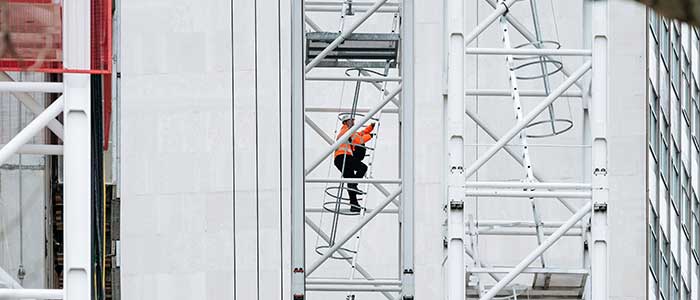Dashpivot Article – Fall Protection Plan Requirements
Fall Protection Plan Requirements
To prevent any sort of fall accidents, every vital requirement of fall protection must be in place and integrated in formulating the plan. This article will get you up to speed on the requirements so you can build a solid fall protection plan that actually works.

Table of Contents
Article Summary
- A Fall Protection Plan that follows a procedural process provides workers with thorough instructions on how to perform tasks at heights safely and appropriately while preventing unintended mishaps.
- The fall protection plan should include the legal requirements and standards, which include clearly defined roles and duties, hazard identification, appropriate control measure selection, thorough procedures, and equipment inspection.
- Providing a fall protection plan is vital for the safety of sectors where working at heights is a routine activity. This plan aims to establish safety for every working-at-heights activity and ensure compliance with regulations.
Why are Fall Protection Plan Requirements essential?
Fall protection plan requirements are vital for ensuring worker safety in sectors where working at heights is routine. This details the necessary elements for an effective fall protection plan, including hazard identification, selection of prevention and protection systems, and the establishment of rescue procedures. This procedural aspect of creating your plan covers and controls every hazard and risk, ensuring that every work-from-height activity is safe and compliant with regulations.
As per OSHA, workers who are six feet or more above lower levels are at risk for serious injury or death if they should fall. To protect these workers, employers must provide fall protection and the right equipment for the job, including the right kinds of ladders, scaffolds, and safety gear.
Furthermore, compliance is a legal requirement. Establishing a complete fall protection plan helps avoid any legal problems and administrative damages. Additionally, it also signifies an organization's dedication to its workforce's safety and well-being. A robust fall protection plan that satisfies essential fall protection requirements supports a proactive approach to safety, greatly reducing fall incident risks.
A Fine example of a Fall Protection Plan
The effectiveness of a fall protection plan depends greatly on how well the workers understand it. Having said this, the plan should be formatted comprehensively so that it outlines a thorough procedure that workers can easily follow and understand to establish all the necessary control measures to prevent fall accidents. In other words, a good format leads to a successful execution of the plan.
The format shown below is a good example of how your fall protection plan should look. The layout arranges all the requirements in the plan like a procedure, which breaks down the complexity into a more actionable guide that employees can perform. Additionally, this format enables you to perform inspections, checks, and data entry quicker, saving you time for other important work.

Use this Fall Protection Plan format for yourself for free
What are the Fall Protection Plan Requirements?
A safe and efficient execution of completing work at heights requires a solid plan that guides workers on how to perform their jobs. To achieve and maintain these outcomes, requirements were implemented to structure a standard fall protection plan. The requirements that need to be present in a standard plan are:
A Defined Roles and Responsibilities
The first requirement of the fall protection plan is to have defined roles and responsibilities. This information should detail the person designated to perform a specific role. This approach places clear responsibilities on each person assigned and avoids any confusion during the process of performing work. Additionally, it is a requirement to outline the entire organizational structure to emphasize the chain of command. Such an arrangement provides a clear direction for where workers need to report, especially when there is a concern or an incident taking place.
Hazard Identification
The next step in creating your plan is to integrate a hazard identification. You need to review all the work activities, pick out the probable hazards in each procedure, and evaluate the risk associated with each hazard. Taking into account all potential hazards guarantees the safety of the entire activity procedure, as it allows for the provision of their control measures. Furthermore, this important procedure is detrimental to the selection of the appropriate control measures for each identified hazard.
Selecting the Appropriate Fall Control Measures
After the hazards have been identified and the risk evaluated, the selection of the appropriate control measure would properly follow. This requirement suggests using the tiered hierarchy of fall protection controls as a guide for selecting control measures. The hierarchy is as follows:
- Eliminate the fall hazard: The purpose of this control measure is to eliminate the possibility of the task being done above ground to prevent any fall dangers. You can accomplish this by moving the job below ground or using equipment to prevent individuals from coming above ground.
- Passive Fall Restraint: If elimination is not possible, providing passive fall restraints should be the next option. This safety system works automatically without any worker interaction. The control measure should include the installation of physical barriers like guardrails and parapets. This provides workers with a physical barrier that keeps them away from exposed edges, holes, or elevated platforms. Aside from being a barrier, the restraints also provide workers additional support when working in such areas.
- Active Fall Restraint: Active fall restraint systems should be considered if a passive fall restraint is not applicable. Alternatively, to enhance protection, consider implementing this method concurrently with the passive fall restraint system. This fall restraint needs the user's involvement for it to function optimally. Examples of such are lanyards, anchors, and full-body harnesses.
- Fall Arrest Systems: When passive or active fall restraints cannot be provided, employers should consider deploying a fall arrest system. If a fall occurs, this system prevents the employee from hitting the ground, reduces the impact force on the body, and reduces the momentum of the fall to a softer landing. It is important to understand that this system does not prevent falls but reduces their consequences when they occur. Having said that, we should use this type of approach as a last resort when selecting the control measures.
Equipment Inspection
A control measure can only be effective if it is working properly. A defective or non-functional control measure could be fatal because of complacency. Therefore, an equipment inspection is required to prevent such unwanted events. This process aims to ensure that the provided control measures are in optimal condition to perform their functions effectively, ensuring the safety of the workers relying on them.
Systematic Procedures
All activities that involve working at heights must establish a standard, and the implementation of structured procedures is the only way to achieve this. The use of these standard processes guarantees that the activity will always be carried out in a healthy and risk-free manner. Without any variation in the steps, there is no space for errors that might potentially expose the individual to different risks.
Emergency Action Plan
The emergency action plan is one of the essential documents in the fall protection plan. When a comprehensive emergency response plan is in place, it is possible to reduce a significant number of hazards and thereby save a significant number of lives. This document provides comprehensive instructions for all potential fall emergencies that may arise.
How to Effectively Implement a Fall Protection Plan?
Various Trainings & Seminars
To ensure that the fall protection plan is carried out in an appropriate manner, it is essential that every employee participate in the various trainings, seminars, and exercises. Employees can learn the company's policies and procedures through seminars and training. When they are operating at heights, such instruction will provide them with the necessary understanding of the appropriate processes to follow.
Supervision and Monitoring
Establishment supervisors provide oversight for activities that involve working at heights. They should always implement the established plan to prevent any variation, which might invite other hazards during the activity. Having said that, the supervisor must be competent enough to enforce this plan on the team; otherwise, it could lead to the disruption of the proper working sequence.
Audits
Regular inspections or audits of the fall protection plan are necessary. By doing this, we can easily identify any gaps in the existing procedures and provide appropriate solutions to address them. Regularly enhancing the processes and procedures outlined in this plan not only improves the safety of the activities that take place while working at heights, but it also provides the workers with a more secure working environment.
A Smart Strategy for Better Fall Protection Planning
The process of creating requirements for the plan should not add fuel to the fire of the already tedious nature of planning. Each requirement necessitates compliance with documents and records, as we've discussed previously in this article. However, with the current trend in technology, there is now an easier way to comply with all of these requirements. Using only a few clicks, taps, and swipes, all necessary procedural requirements could now be met using the Fall Protection Plan Software. This digital application allows you to convert all your paper forms into digital forms in a manner that suits your workflow. Furthermore, you can store these forms in a central register, allowing instant access and retrieval using a digital device. It gives you complete visibility over all your fall protection plans and allows you to refer to and make changes to them at the touch of a button. To learn more about other digital forms, visit this safety forms directory.
Summary of Fall Protection Plan Requirements
A fall protection program must have all the necessary requirements to effectively maintain safety, especially in industries where working at heights is common. The purpose of these requirements is to ensure that employees know and understand their roles, that all hazards are accounted for and provided with measures, that control measures are effectively working, that standard procedures are established, and that they are prepared for fall emergencies. By meeting all of these requirements, the fall protection plan not only protects the employees from the fall hazards but also promotes a proactive safety culture in the workplace.
Frequently Asked Questions
Is the Fall Protection Plan required in the construction insdustry?
Yes - The construction industry is well known for having multiple activities that involves working at heights. You can easily comply to area regulations by using a fall protection plan that incorporates the complete requirements.
How is technology changing how people conduct effective fall protection planning?
Technology is transforming fall protection planning by replacing manual paperwork and static site plans with digital solutions like Dashpivot. Teams can now complete hazard assessments faster, automate compliance documentation, and update site-specific plans in real time. This leads to significant time savings, improved accuracy, better regulatory compliance, and ultimately safer worksites.
Does Sitemate offer other safety forms involving working at heights?
Yes - Sitemate offers ready-to-use and editable Scaffolding Safe Work Method Statement that can also be edited for your workflow. Right now, businesses of all sizes that employ scaffolds in their operations use these templates to create a document outlining the safety procedures and practices, the risks, and the controls that must be put in place.
Related resources

Working at Heights Risk Assessment
Improve working at heights safety by following and completing this working at heights risk assessment template.

Safe Work Method Statement for Working at Heights
Reduce the likelihood and consequences associated with terrible working at heights incidents by better managing and communicating your SWMS.

Job Hazard Analysis for Working at Height
Keep your fear of heights in check with this working at heights Job Hazard Analysis template.




